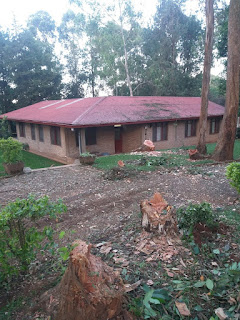(from Eric)
Sunday morning, I woke with worries I didn't think that I had.
In that liminal space where you're not quite asleep, but you still have no control over what you're thinking about, my mind raced. It was probably five in the morning. It was still dark outside but the birds were loud enough to shake up some part of my subconscious. I was fretting. I was worrying about the medical school three years from now. I was worrying about our water supply in the next day. It was like a parade of anxiety.
Strangely, I hadn't gone to bed worried, or even thinking, about any of those things. I didn't think I was actually that stressed about any of them. However, they say that, if you want to know what you worship, notice where your mind goes when you have nothing to distract it. Or maybe where your mind goes when you're just awake to notice what you're powerless to stop thinking about.
Somewhere in my stupor thoughts, I realized it was Sunday morning, and I tried to tell myself that this was the dumbest moment of the week to worry about anything. But, to no avail. The mental catastrophizing continued.
Through the fog, I remembered Jesus' words from Matthew 6 about not worrying about tomorrow. "Why wouldn't I worry? It could be really bad." Then a mental response: "The only reason to not worry is that God your Father is actually sovereign."
I drifted off, and woke later, wishing I had slept better, and got ready for church.
***
After the songs, the welcoming of visitors, and the offering which always encourages us to dance, we sit down in our plastic lawn chairs to listen to the sermon. This week it will be given by Elysé.
I met Elysé years ago when he was a local teenager playing different instruments in the church worship band. He seemed invariably cheerful, and would sometimes lead a prayer. I remember him preaching for the first time. He went away from some additional studies, but was soon back, and would often come out on Sunday afternoons and play ultimate frisbee with us.
Last year, I was taking care of an older man on our Internal Medicine service, and he wasn't doing well. I learned that this was Elysé's dad just a couple days before he passed away. Elysé has always struck me as kind and also joyful, and he found a way to show these qualities even in the grief of his father's passing and the fears that can bring about. I was delighted and thankful to see him hired by the hospital the following month as a secretary. These days, when I come in for morning prayer, he's often playing the guitar, and when I go into the Admin wing, he smiles and greets me, most often in English.
***
So, Elysé stands up and says that he is going to speak today in English, because we have several visitors that don't speak French. He says that today, he wants to tell us all: Don't worry. He reads out of Matthew 6 where Jesus says don't worry about what you will eat, because you are more valuable than sparrows, and don't worry about what you will wear, because you are more valuable than flowers.
Verily, verily, I say to you that I've never really worried much about food or clothing in my life. I've always had them, but Elysé might have had good reason to worry when his father passed away. He mentioned that time of his life, and then he quoted Psalm 68:5 in English from memory: "A father to the fatherless, a defender of widows, is God is his holy dwelling." "Don't worry," says Elysé with a smile, "because if you have Jesus, you have everything."
***
I think you can imagine how these words were a balm to my heart, and not just the words, but hearing them from Elysé. I spend my years teaching and studying, and Elysé, maybe 25 years old ("still single and searching" he introduced himself), stands up and says the simple words in the simple way that I need to hear.
What do I worry about? It's not food and clothing, like Matthew 6 talks about, or even basic financial security, like any rural Burundian family would worry about when their father passes away before they have a job. What do I worry about? Meaning, I guess. Having my life "count" and "making an impact for something that really matters". That's certainly something that moth and rust can destroy. That's certainly something that I also need to lay down and commit into the hands of a loving Father.
But maybe it's not "meaning" or "impact". Maybe it's just worry. Maybe I just worry about the next thing. If I had food insecurity, I'd worry about that, but that being shorn up, I move on to the next thing. I worry about whatever the leading edge happens to be. Truth be told, I've been giving incredibly meaningful work in my life, and the opportunity to have a great impact. But it (like everything) is limited, so my worry lies wherever the uncertainty happens to be.
"Don't worry," says Elysé. "If you have Jesus, you have everything. God is a father to the fatherless and a defender of widows. Don't worry."
***
Final thought: My early morning worries were truly incongruous and surprising. Could it be that they were given to me in order that I might truly listen to the words of the sermon? Could it be that my 5 a.m., uncontrolled, heart fretting was actually a grace to me?































